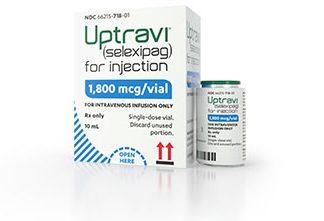Why is this medication prescribed?
Adults with pulmonary arterial hypertension (PAH, or high blood pressure in the blood arteries supplying the lungs) who are taking selexipag pills but are momentarily unable to take them orally can utilize selexipag injection. A class of drugs known as selective nonprostanoid IP prostacyclin receptor agonists includes selenipag injection. It functions by letting blood flow more freely by relaxing the blood arteries in the lungs.
How should this medicine be used?
The injectable form of selenipag is a liquid that is administered intravenously (into a vein). Usually, a nurse or doctor will inject it gradually over the course of 80 minutes. For as long as you are unable to swallow selexipag tablets, it is typically administered twice daily.
Request a copy of the patient’s manufacturer’s information from your pharmacist or physician.
It’s essential for patients to communicate openly with their healthcare providers regarding their symptoms, any side effects experienced, and any other medications or supplements they are taking. Only a qualified healthcare professional can determine the appropriate dosage and monitor the patient’s response to selenipag injection effectively.
Other uses for this medicine
Selexipag is primarily approved for the treatment of pulmonary arterial hypertension (PAH), and its use for other conditions is not common. The medication works specifically by targeting the prostacyclin pathway to dilate blood vessels in the lungs. Therefore, its use is generally limited to the management of PAH.
What special precautions should I follow?
Regarding special precautions, it’s crucial to follow your healthcare provider’s advice and guidelines. Generally, when using medications like selexipag, here are some precautions that may apply:
- If you have an allergy to any of the substances in selexipag injection, other drugs, or selexipag itself, let your doctor and pharmacist know. Get an ingredient list from your pharmacist.
- Inform your physician if you use Lippid (gemfibrozil). If you take this drug, your doctor could advise against using selexipag injection.
- Inform your physician and pharmacist about any additional prescription and over-the-counter drugs, vitamins, dietary supplements, and herbal remedies you now take or intend to use. Make sure to bring up any of the following: teriflunomide (Aubagio), rifampin (Rifadin, Rimactane), deferasirox (Exjade, Ferriprox, Jadenu), and clopidogrel (Plavix). Your doctor might need to carefully monitor you for any negative effects or adjust the dosages of your medications. Tell your doctor about all the medications you take, including ones that are not on this list, since many other medications may also interact with selexipag injection.
- Inform your physician if you now have or have previously had liver disease, thyroid issues, or pulmonary veno-occlusive disease (PVOD; pulmonary vein occlusion).
- Inform your physician if you are nursing a baby, intend to get pregnant, or are already pregnant. Contact your physician if you become pregnant while taking selexipag injections.
Always consult with your healthcare provider for personalized advice and information regarding the use of Selexipag, especially if you have any pre-existing medical conditions or are taking other medications.
What special dietary instructions should I follow?
There are no specific dietary restrictions associated with selexipag injection. However, it’s essential to maintain a balanced and healthy diet as part of an overall healthy lifestyle. If you have any concerns or questions about your diet while taking selexipag, discuss them with your healthcare provider or a registered dietitian.
What side effects can this medication cause?
Selexipag injection may have adverse effects. If any of these symptoms are severe or persistent, let your doctor know:
- Redness, pain, tenderness, swelling, discoloration, itching, or bruising of the skin where selexipag was injected
- Headache
- Pain in jaw, joints, muscles, arms, or legs
- Decreased appetite
- Nausea
- Diarrhea
- Vomiting
- Flushing
- Rash
Certain adverse effects may be dangerous. Give your doctor a call right away if you encounter any of the following symptoms:
- Shortness of breath
- Rapid breathing
- Dizziness
- Weakness
Other adverse effects are possible with selexipag injection. If you have any odd side effects while taking this medicine, contact your doctor.
What should I know about storage and disposal of this medication?
Storage and Disposal:
- Storage: Typically, medications should be stored at room temperature away from light and moisture unless otherwise specified. Follow the storage instructions provided by your healthcare provider or on the medication’s packaging.
- Disposal: Dispose of unused or expired medications as per local regulations and guidelines. Do not flush medications down the toilet unless instructed to do so. Check with your pharmacist or local waste disposal facility for proper disposal methods.
In case of emergency/overdose
In case of an emergency or suspected overdose, seek medical attention immediately. The signs of overdose or serious side effects may include severe hypotension (low blood pressure), dizziness, and other symptoms related to the cardiovascular system.
What other information should I know?
- Follow Healthcare Provider’s Instructions: Always follow your healthcare provider’s instructions regarding the use of selexipag. Take the medication exactly as prescribed, and do not alter the dosage without consulting your healthcare provider.
- Regular Monitoring: Regular follow-up appointments with your healthcare provider are important to monitor your response to selexipag and adjust the treatment plan if necessary.
- Inform Healthcare Provider: Keep your healthcare provider informed about all medications, including prescription and over-the-counter drugs, supplements, and herbal products, that you are taking. This information is crucial to avoid potential drug interactions.
- Medical Conditions: Inform your healthcare provider of any existing medical conditions, especially liver problems, as selexipag is metabolized by the liver.
- Pregnancy and Breastfeeding: If you are pregnant, planning to become pregnant, or breastfeeding, discuss this with your healthcare provider. The potential risks and benefits of using selexipag during pregnancy and breastfeeding should be evaluated.
Always consult with your healthcare provider or pharmacist for the most accurate and up-to-date information based on your specific situation. If there have been updates or changes since my last knowledge update, your healthcare provider will have the latest information.


